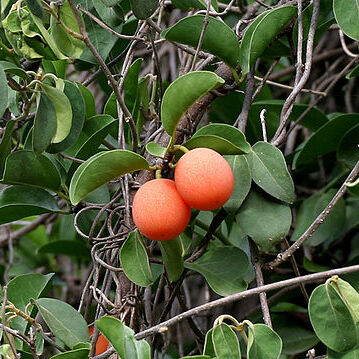Root-parasitic shrubs or low trees. Branches usually armed with axillary spines and/or ramal thorns. Leaves spiral, sometimes fascicled on brachyblasts. Inflorescences axillary, or at the end of a short lateral branch (which may turn into a thorn), rather few-flowered pedunculate, sometimes umbel-like cymes, or flowers in fascicles, rarely solitary. Calyx small, saucer-shaped, with (3-)4(-5) teeth or sepals, persistent, hardly or not accrescent in fruit; petals 4 (rarely 5), free, linear-oblong, upper half recurved, with a brush of hairs on the inner surface, caducous; stamens free, hypogynous, usually twice the number of petals, filaments filiform, anthers oblong-linear to subovate; disc absent; ovary superior, (3-)4-locular in the basal part, style more or less columnar, stigma capitate, small. Drupe with a rather thin pulpy pericarp, and a crustaceous to woody endocarp; endosperm copious, oily, embryo very small.
Trees or shrubs; branches usually armed with spines. Leaves alternate, entire. Flowers borne in axillary fascicles or pedunculate cymes, sometimes solitary, 4–5-merous, bisexual. Calyx small, 4–5-lobed, not accrescent. Petals 4–5, valvate, linear-oblong, densely pilose on the inner surface, glabrous to sparsely pubescent on the outer surface. Stamens 8 (rarely 10), free, 4(–5) opposite the petals and 4(–5) alternating with them; filaments filiform; anthers linear-oblong, erect, longitudinally dehiscent. Ovary superior, 3(–4)-partite almost to the apex of the ovary; ovules 3–4, pendulous, anatropus; style short; stigma capitate. Fruit a drupe, ovoid to globose.
Shrubs or low trees. Branchlets often spine-tipped. Leaves alternate or fascicled on short shoots; veins pinnate. Inflorescences a fascicle or cyme. Calyx cupular, 4-or 5-dentate, persistent, not accrescent. Petals 4 or 5, free, densely villous on inside, apical 1/2 revolute. Stamens 8 or 10; filaments filiform; anthers linear. Disk absent. Ovary superior, (3 or)4-loculed, placenta axile; ovules 3 or 4. Style ± slender; stigma capitate. Drupe ovoid, 1-seeded.
Shrubs or trees. Lateral branchlets often divaricate. Leaves alternate, often crowded, somewhat succulent; lateral nerves evident. Flowers bisexual, in axillary umbels or racemes. Hypanthium absent. Calyx 4-lobed. Corolla tubular; lobes 4, easily parted, pale yellow to white, caducous. Stamens 7; staminodes 0. Ovary 4-locular; style slender; stigma not lobed.
Ovary free, lageniform, usually 4-locular nearly to the apex; placenta central, columnar; ovules 2–4, apical, pendulous, anatropous; style short; stigma minute, capitate.
Petals 4 (5), linear-oblong, later recurved, glabrous to pubescent outside, densely bearded within.
Stamens usually 8, 4 opposite the petals and 4 alternating with them, free.
Flowers axillary, solitary or fasciculate or in pedunculate cymes.
Shrubs or small trees up to 6 m. tall, usually spiny.
Leaves obtuse to retuse, mucronulate.
Fruit drupaceous with a large stone.
Calyx 4 (5)-lobed, not accrescent.

